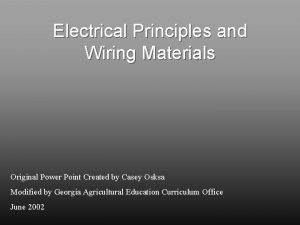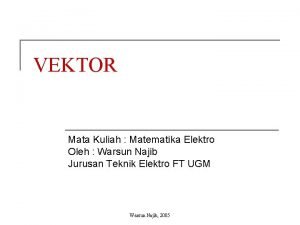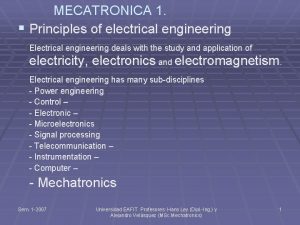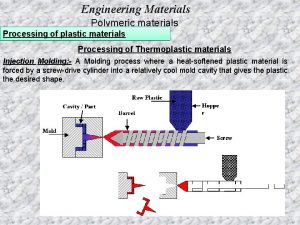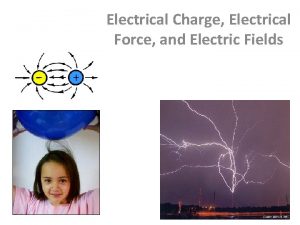Electrical Engineering Materials EE 3219 Dr Md Sherajul




























- Slides: 28

Electrical Engineering Materials EE 3219 Dr. Md. Sherajul Islam Department of Electrical and Electronic Engineering Khulna University of Engineering & Technology Khulna, Bangladesh

LECTURE - 5 Modern Theory of Solids

Time-independent Schrödinger equation Infinite Square-Well Potential • The simplest such system is that of a particle trapped in a box with infinitely hard walls that the particle cannot penetrate. This potential is called an infinite square well and is given by • Clearly the wave function must be zero where the potential is infinite. • Where the potential is zero inside the box, the Schrödinger wave equation becomes • The general solution is where. .



Finite Square-Well Potential • The finite square-well potential is • The Schrödinger equation outside the finite well in regions I and III is or using yields . The solution to this differential has exponentials of the form eαx and e-αx. In the region x > L, we reject the positive exponential and in the region x < L, we reject the negative exponential.

Finite Square-Well Solution • Inside the square well, where the potential V is zero, the wave equation becomes where • Instead of a sinusoidal solution we have • The boundary conditions require that and the wave function must be smooth where the regions meet. • Note that the wave function is nonzero outside of the box.

Band structure of Solids The energy spectrum gradually changes as atoms are assembled to form the solid

Band Theory of Solids Molecular orbital formation Two ways: both same direction (+) Or opposite direction (-)

Molecular orbital formation The bonding orbital shows a local minimum in the wavefunction but the function does not go to zero. Thus there is a finite probability of finding the electron between the 2 atoms. The anti-bonding orbital wavefuntion goes to zero hence the probability of finding the electron between the 2 atoms is zero. This is called a node.

Molecular orbital formation Figure 1. 3: (a) Energy vs. bond length plot for 2 H atoms. (b) The schematic representation of the formation of the H 2 molecule. Both electrons go to the bonding orbital while the anti-bonding orbital is empty.

Figure 1. 4: MOs formed when 3 H atoms come together. The number of nodes increases while the stability decreases. The configuration with the lowest number of nodes is most stable.

Figure 1. 6: Energy vs. bond length diagram for N Li atoms. There a total of 2 N energy states (including spin) out of which N are occupied, half full. This makes Li a metal

Figure 1. 7: Energy vs. bond length diagram for large values of N showing a continuous band formation. The overlap between the 2 s, 2 p, and 3 s levels are also shown The separation between the filled states and the empty states is called the Fermi energy and is denoted by EF The energy required to remove an electron from the Fermi level to vacuum level (where the electron is free of the influence of the metal) is called the work function. The band formed by the empty 2 p shell as the conduction band.

Figure 1. 8: Fermi energy and work function in Li. By convention the vacuum level is taken as zero and energy levels within the metal are shown as negative. If the lowest energy level in the valence band is used as reference all these energy levels become positive

Figure 2. 4: Formation of energy bands in Si. (a) Si atom with 4 electrons in outer shell form (b) 4 sp 3 hybrid orbitals. (c) The hybrid orbitals form σ and σ ∗ orbitals. (d) These orbitals overlap in a solid to form the valence and conduction band.

Properties of Electron in a Band

Properties of Electron in a Band

Electron Effective Mass

Electron Effective Mass

E-K Diagram E

Calculation of Effective mass from E-K Diagram What is the significance of E-K Diagram ? ?

Density of states in an Energy Band The density of states (DOS) of a system describes the number of available states per unit energy per unit volume

Density of states in an Energy Band

Density of states in an Energy Band Detail derivation of DOS from Book

Boltzman Classical Statistics In statistical mechanics, Maxwell–Boltzmann statistics describes the average distribution of non-interacting material particles over various energy states in thermal equilibrium, and is applicable when the temperature is high enough or the particle density is low enough to render quantum effects negligible.

Boltzman Classical Statistics

Fermi-Dirac Statistics In quantum statistics, a branch of physics, Fermi–Diracstatistics describe a distribution of particles over energy states in systems consisting of many identical particles that obey the Pauli exclusion principle.
 Dr. md. sherajul islam
Dr. md. sherajul islam Dr. md. sherajul islam
Dr. md. sherajul islam What are the protocols in making electrical gadgets
What are the protocols in making electrical gadgets Unit 33 electrical principles and wiring materials
Unit 33 electrical principles and wiring materials Magnetic materials used in electrical machines
Magnetic materials used in electrical machines Unit 33 electrical principles and wiring materials
Unit 33 electrical principles and wiring materials Favourite cars
Favourite cars Material that are useful and harmful
Material that are useful and harmful Man made materials
Man made materials Differentiate adopting materials and adapting materials
Differentiate adopting materials and adapting materials Direct materials budget with multiple materials
Direct materials budget with multiple materials Vector electrical engineering
Vector electrical engineering Gwu electrical engineering
Gwu electrical engineering Tel aviv university electrical engineering
Tel aviv university electrical engineering Electrical engineering northwestern
Electrical engineering northwestern Klipsch school of electrical and computer engineering
Klipsch school of electrical and computer engineering Electrical engineering department
Electrical engineering department Electrical engineering umd
Electrical engineering umd Batten wiring diagram
Batten wiring diagram Electrical engineering environmental issues
Electrical engineering environmental issues Umassd electrical engineering flowchart
Umassd electrical engineering flowchart Electrical engineering presentation
Electrical engineering presentation Electrical engineering kfupm
Electrical engineering kfupm Big data in electrical engineering
Big data in electrical engineering Chapter 11 electrical engineering
Chapter 11 electrical engineering Basic electrical engineering kulshreshtha
Basic electrical engineering kulshreshtha University of belgrade school of electrical engineering
University of belgrade school of electrical engineering Electrical engineering notation
Electrical engineering notation Ntou ee
Ntou ee





